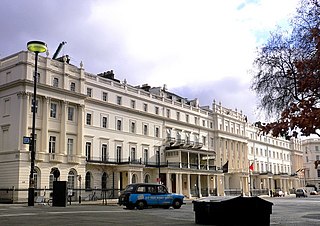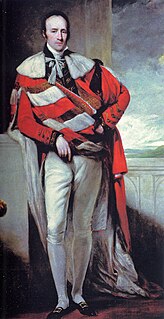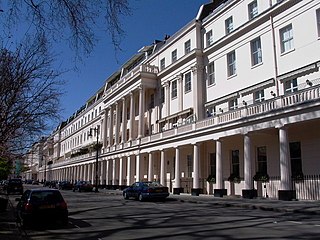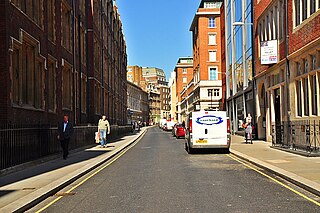
The West End of London is a district of Central London, west of the City of London and north of the River Thames, in which many of the city's major tourist attractions, shops, businesses, government buildings and entertainment venues, including West End theatres, are concentrated.

Mayfair is an affluent area in the West End of London towards the eastern edge of Hyde Park, in the City of Westminster, between Oxford Street, Regent Street, Piccadilly and Park Lane. It is one of the most expensive districts in the world.

Pimlico is an area of Central London in the City of Westminster, built as a southern extension to neighbouring Belgravia. It is known for its garden squares and Regency architecture. It is demarcated to the north by Victoria Station, and bounded by the River Thames to the south, Vauxhall Bridge Road to the east and the former Grosvenor Canal to the west. At its heart is a grid of residential streets laid down by the planner Thomas Cubitt, beginning in 1825 and now protected as the Pimlico Conservation Area. Additions have included the pre–World War II Dolphin Square and the Churchill Gardens and Lillington and Longmoore Gardens estates, now conservation areas in their own right. The area has over 350 Grade II listed buildings and several Grade II* listed churches.

Park Lane is a major road in the City of Westminster, in Central London. It is part of the London Inner Ring Road and runs from Hyde Park Corner in the south to Marble Arch in the north. It separates Hyde Park to the west from Mayfair to the east. The road has a number of historically important properties and hotels and has been one of the most sought after streets in London, despite being a major traffic thoroughfare.

Belgravia is an affluent district in Central London, covering parts of the areas of both the City of Westminster and the Royal Borough of Kensington and Chelsea.

Berkeley Square is a green town square in Mayfair in the West End of London, in the City of Westminster. It was laid out, extending further south, in the mid 18th century by the architect William Kent.

Grosvenor House was one of the largest townhouses in London, home of the Grosvenor family for more than a century. Their original London residence was on Millbank, but after the family had developed their Mayfair estates, they moved to Park Lane to build a house worthy of their wealth, status and influence in the 19th century. The house gave its name to Upper Grosvenor Street and Grosvenor Square.

Grosvenor Square is a large garden square in the Mayfair district of London. It is the centrepiece of the Mayfair property of the Duke of Westminster, and takes its name from the surname "Grosvenor". The unique floor plans, detailed elevations, 3D façade model for the building was done by Michael Gallie.

Grosvenor Group Limited is an internationally diversified property group, which traces its origins to 1677 and has its headquarters in London, England. It has a global reach, now in 62 international cities, with offices in 14 of them, operated on behalf of its owners, the Duke of Westminster and his family. It has four regional development and investment businesses and a portfolio of indirect investments. Its sectors include residential, office, retail, industrial, along with hotels.

Robert Grosvenor, 1st Marquess of Westminster was the son of the 1st Earl Grosvenor, whom he succeeded in 1802 as 2nd Earl Grosvenor. He was created Marquess of Westminster in 1831. He was an English Member of Parliament (MP) and an ancestor of the modern-day Dukes of Westminster. Grosvenor continued to develop the family's London estates, he rebuilt their country house, Eaton Hall in Cheshire where he also restored the gardens, and built a new London home, Grosvenor House. He maintained and extended the family interests in the acquisition of works of art, and in horse racing and breeding racehorses.

Brook Street is an axial street in the exclusive central London district of Mayfair. Most of it is leasehold, paying ground rent to and seeking lease renewals from the reversioner, that since before 1800, has been the Grosvenor Estate. Named after the Tyburn that it crossed, it was developed in the first half of the 18th century and runs from Hanover Square to Grosvenor Square. The western continuation is called Upper Brook Street; its west end faces Brook Street Gate of Hyde Park. Both sections consisted of neo-classical terraced houses, mostly built to individual designs. Some of them were very ornate, finely stuccoed and tall-ceilinged, designed by well known architects for wealthy tenants, especially near Grosvenor Square, others exposed good quality brickwork or bore fewer expensive window openings and embellishments. Some of both types survive. Others have been replaced by buildings from later periods.

Eaton Square is a rectangular, residential garden square in London's Belgravia district. It is the largest square in London. It is one of the three squares built by the landowning Grosvenor family when they developed the main part of Belgravia in the 19th century that are named after places in Cheshire — in this case Eaton Hall, the Grosvenor country house. It is larger but less grand than the central feature of the district, Belgrave Square, and both larger and grander than Chester Square. The first block was laid out by Thomas Cubitt from 1827. In 2016 it was named as the "Most Expensive Place to Buy Property in Britain", with a full terraced house costing on average £17 million — many of such town houses have been converted, within the same, protected structures, into upmarket apartments.

Grosvenor Canal was a canal in the Pimlico area of London, opened in 1824. It was progressively shortened, as first the railways to Victoria Station and then the Ebury Bridge housing estate were built over it. It remained in use until 1995, enabling barges to be loaded with refuse for removal from the city, making it the last canal in London to operate commercially. A small part of it remains among the Grosvenor Waterside development.

The 18th century was a period of rapid growth for London, reflecting an increasing national population, the early stirrings of the Industrial Revolution, and London's role at the centre of the evolving British Empire. By the end of the century nearly one million people lived in London, about one tenth of the population of Great Britain. By 1715, London's population reached an estimated 630,000 people, roughly equaling that of Europe's largest city until that time, Paris. Within a few years London itself was the largest city in Europe, reaching 750,000 people by 1760 and 1 million by the end of the century.

Chancery Lane is a one-way street situated in the ward of Farringdon Without in the City of London. It has formed the western boundary of the City since 1994, having previously been divided between the City of Westminster and the London Borough of Camden. The route originated as a 'new lane' created by the Knights Templar from their original 'old Temple' on the site of the present Southampton Buildings on Holborn, in order to access to their newly acquired property to the south of Fleet Street sometime before 1161.

St George Hanover Square was a civil parish in the metropolitan area of London, England. The creation of the parish accompanied the building of the St George's Hanover Square Church, constructed by the Commission for Building Fifty New Churches to meet the demands of the growing population. The parish was formed in 1724 from part of the quite early medieval parish of Saint Martin in the Fields in the consequent Liberty of Westminster, hundred of Ossulstone and county of Middlesex. It included some of the most fashionable areas of the West End of London, including Belgravia and Mayfair. Civil parish administration, known as a select vestry, was dominated by members of the British nobility until the parish adopted the Vestries Act 1831. The vestry was reformed again in 1855 by the Metropolis Management Act. In 1889 the parish became part of the County of London and the vestry was abolished in 1900, replaced by Westminster City Council. The parish continued to have nominal existence until 1922. As created, it was a parish for both church and civil purposes, but the boundaries of the ecclesiastical parish were adjusted in 1830, 1835 and 1865.

St George's Square is a very long garden square in Pimlico, London which has the buildings of a church in its central area. Just short of its northern acute angle, part pedestrianised, it intersects a minor road, Lupus Street. Pimlico tube station is a short distance east. Its north-east side is in effect Belgrave Road and southern side is arterial Grosvenor Road which is lined by a small public garden in front of the River Thames.
Somerset House, Park Lane, was an 18th-century town house on the east side of Park Lane, where it meets Oxford Street, in the Mayfair area of London. It was also known as 40 Park Lane, although a renumbering means that the site is now called 140 Park Lane.

Trevor Square is an elongated garden square in Knightsbridge, London. It was designed in the 1810s chiefly by architect William Fuller Pocock, and the mid-rise, basemented houses fronting its two long sides, with slate mansard roofs are listed in the British protective and recognising scheme, and were built in the 1820s. The main stonemason employed was Lancelot Edward Wood after whom is named neighbouring street Lancelot Place.

South Audley Street is a major shopping street in Mayfair, London. It runs north to south from the southwest corner of Grosvenor Square to Curzon Street.




















